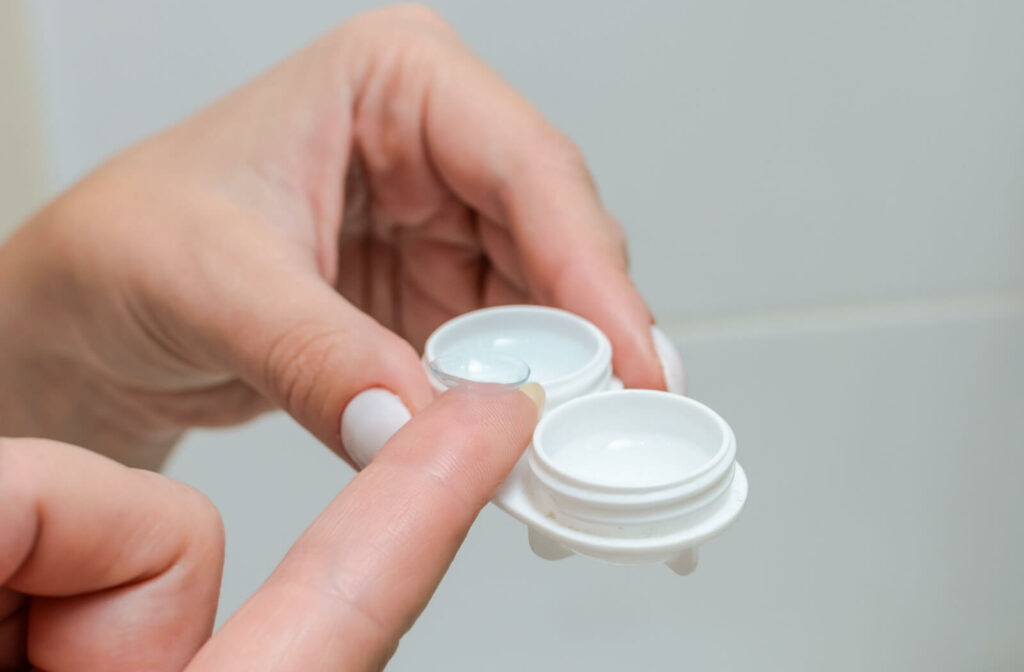Contact lenses may seem like small, simple items, but there’s much more to them than meets the eye. The lifespan of a contact lens can vary greatly depending on its type, how well it’s taken care of, and individual eye health. Depending on its design, contact lenses can be good for a single use or may last for several weeks to a month.
In today’s fast-paced world, contact lenses offer a convenient alternative to glasses, giving millions the freedom to live without frames. However, many contact lens wearers are unaware that using lenses beyond their recommended time frame can lead to discomfort and other complications. Knowing how long your lens should last is vital to maintaining vision clarity and eye health.
Types of Contact Lenses
Before we can determine a contact lens’s lifespan, we need to know what type of lens it is. There are 3 common categories of contact lenses, each with a different standard lifespan.
Daily Disposable Lenses
Daily disposable lenses are designed for single use. A fresh pair of lenses is worn daily.
Daily disposables are ideal for people with sensitive eyes or those who prefer the convenience of not having to clean their lenses daily. These lenses reduce the risk of eye infections and allergies, as they’re discarded after each use, which eliminates any build-up of protein deposits.
Bi-weekly & Monthly Lenses
Bi-weekly and monthly lenses are designed for more extended wear, ranging from 2 weeks to a month, depending on the product. These lenses require daily cleaning and storage, and users must adhere to a strict hygiene routine to avoid complications such as dry eyes or infections.
Extended Wear Lenses
For those who prefer to wear lenses overnight, extended-wear lenses are designed for continuous use, typically up to seven days and nights or sometimes even longer. These lenses allow for extended wear without compromising eye health because they’re made from oxygen-permeable materials.
Factors Affecting the Lifespan of Contact Lenses
Even if a pair of contact lenses is designed to last 2 weeks or a month, that doesn’t mean they’ll always last that long. A variety of different factors can affect the longevity of a lens.
Environmental Influences
Environmental factors play a significant role in the longevity of contact lenses. Environmental pollution, air quality, and exposure to dust can all accelerate wear and tear.
Daily disposable lenses might be preferable, for instance, for those living in urban areas or who are frequently exposed to harsh environments.
Weather conditions also impact lens wear. During dry seasons or in windy climates, lenses may dry out more quickly, affecting comfort and effectiveness. Applying rewetting drops can help maintain moisture levels and extend wear time.
Hygiene Practices
Proper hygiene is paramount to extending the lifespan of your contact lenses. Always wash your hands before handling lenses and use recommended solutions for cleaning and storing. Avoid using water directly on lenses, as this can introduce bacteria and may lead to severe infections.
Lens Material
A lens’s material also affects its durability. For example, silicone hydrogel lenses typically offer better oxygen permeability and comfort for longer wear times compared to a more rigid material. Selecting a suitable lens material based on an individual’s needs and lifestyle is crucial for optimal performance and lifespan.

Signs Your Contact Lenses Need Replacing
Regardless of how long your lenses should last, there are a few things to consider that indicate it’s time to change them.
Discomfort or Irritation
If your lenses start causing discomfort, this is a sign that they need replacing. Common symptoms include redness, itching, or a gritty sensation in the eyes.
Visual Disturbances
Cloudy vision or the appearance of halos and glare can indicate that your lenses are past their prime. Such disturbances can be distracting and dangerous, especially when driving or performing tasks requiring clear vision.
Physical Damage
Inspect your lenses regularly for signs of damage, such as tears or scratches. If not replaced promptly, damaged lenses can irritate the eye or cause injury. Lens damage can also occur from mishandling or improper storage.
Proper Care & Storage
Cleaning is essential for bi-weekly and monthly lenses. Use only recommended lens solutions to disinfect and store your lenses, and change the solution daily to prevent bacterial growth.
Store lenses in a clean, dry case and replace their case as recommended by the manufacturer in order to minimize contamination. Keeping your lenses and case clean is crucial to maintaining their lifespan and ensuring eye safety.
Spotlight on Precision 7 by Alcon
Precision 7 contact lenses by Alcon are an upcoming extended-wear contact lens designed with advanced materials. These lenses offer high oxygen permeability, making them ideal for up to 7 days of continuous wear.
Precision 7 lenses cater to a variety of prescriptions and visual needs, absorb small amounts of UV light, and enhance the lens-wearing experience. Their innovative design provides excellent vision correction and comfort for users with diverse lifestyles.
Book your contact lens exam and fitting today to discuss these new contacts and determine if they’re right for you.
Discuss Your Contact Lenses with Your Eye Doctor
Understanding the lifespan of your contact lenses is essential for maintaining eye health and ensuring the best possible vision. By choosing the right type of lenses, practicing proper care, and being mindful of their lifespan, you can confidently enjoy the benefits of contact lenses.
Contact us at Fontana Optometric Group if you’re considering entering the contact lens world for the first time or want to discuss a new type of contact lens. We have 3 locations to serve you better.



